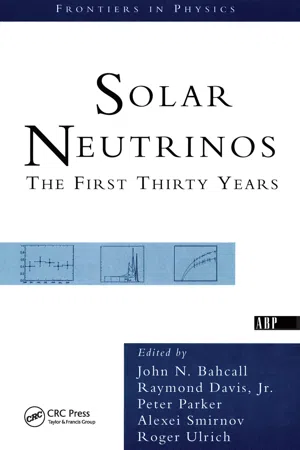
This is a test
- 488 pages
- English
- ePUB (mobile friendly)
- Available on iOS & Android
eBook - ePub
Book details
Book preview
Table of contents
Citations
About This Book
A variety of evolutionary sequences of models for the solar interior has been computed, corresponding to variations in input data, to obtain some idea of the uncertainties involved in predicting a solar neutrino flux. It is concluded that the neutrino flux can be estimated to within a factor of 2, the primary uncertainty being the initial homogeneous solar composition; detailed results are given. With a preferred value of the heavy-element-to-hydrogen ratio Z/X = 0.028, the helium content necessary to fit a model to the observed solar luminosity is found to be Y = 0.27.
Frequently asked questions
At the moment all of our mobile-responsive ePub books are available to download via the app. Most of our PDFs are also available to download and we're working on making the final remaining ones downloadable now. Learn more here.
Both plans give you full access to the library and all of Perlego’s features. The only differences are the price and subscription period: With the annual plan you’ll save around 30% compared to 12 months on the monthly plan.
We are an online textbook subscription service, where you can get access to an entire online library for less than the price of a single book per month. With over 1 million books across 1000+ topics, we’ve got you covered! Learn more here.
Look out for the read-aloud symbol on your next book to see if you can listen to it. The read-aloud tool reads text aloud for you, highlighting the text as it is being read. You can pause it, speed it up and slow it down. Learn more here.
Yes, you can access Solar Neutrinos by Raymond Davis, Jr. in PDF and/or ePUB format, as well as other popular books in Physical Sciences & Physics. We have over one million books available in our catalogue for you to explore.
IV. Physics Beyond the Standard Model
Introduction: Alexei Smirnov
Solar neutrino experiments provide unique information on neutrino propagation in vacuum and in matter. On the way from the central parts of the sun to the terrestrial detectors, the neutrinos can decay, oscillate, undergo resonant flavor conversion, or have their spins precess or flip resonantly. These processes may be manifested in different ways, including an energy-dependent suppression of the electron neutrino flux, the appearance of muon or tau (anti)neutrinos or even electron antineutrinos from the sun, and time variations of the fluxes.
The indicated processes imply the existence of physics beyond the standard model: lepton number violation, non zero neutrino masses and mixing angles, the existence of large magnetic moments of neutrinos, and interactions of neutrinos with new particles.
Oscillations, conversion, and spin-precession all permit the reconciliation of the data from solar neutrino experiments with predictions of standard solar models, i.e. they provide (different) solutions to the solar neutrino problem. Observations of the indicated effects will allow us to measure the neutrino parameters. Negative results of the searches will exclude interesting regions of neutrino parameter space and establish bounds on new physics. In this section, we have collected papers which contain the key theoretical ideas concerning how physics beyond the standard electroweak model can be investigated in solar neutrino studies. To a great extent, the reprinted papers have determined the subsequent development of the field.
As was first shown by Pontecorvo, leptonic charge nonconservation leads to neutrino mixing, and consequently, oscillations of neutrinos. “If the oscillation length is large ... from the point of view of detection possibilities an ideal object is the sun.” This statement from Pontecorvo’s 1967 paper[1] can be considered as the birth certificate for the subject of solar studies of new neutrino physics. Two short paragraphs from this paper contain several important remarks. If the characteristic length of the oscillations is smaller than the neutrino production region, then one predicts an averaged effect: the suppression of the original electron neutrino flux by a factor of two. Pontecorvo quotes the unpublished Pomeranchuk remark that, if the oscillation length is much larger than the production region, one can expect time variations of signals related to the annual changes of the distance between the sun and the Earth (also Paper l.A.IV). Oscillations can explain the discrepancy between observations and theoretical predictions (Paper l.A.IV, also re...
Table of contents
- Cover
- Half Title
- Title Page
- Copyright Page
- Frontiers in Physics
- Editor’s Foreword
- Contents
- Preface
- I Standard Model Expectations
- II Solar Neutrino Experiments
- III Nuclear Fusion Reactions
- IV Physics Beyond the Standard Model
- V Helioseismology
- VI Transition from “Problem” to “Opportunity”
- Permissions and Acknowledgments